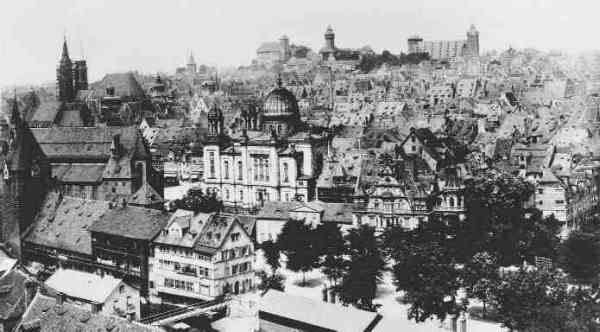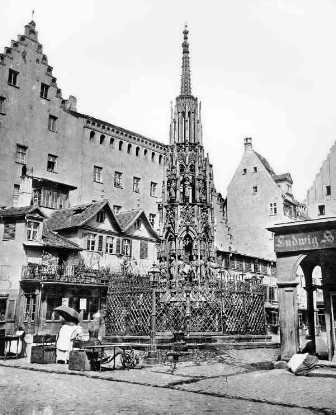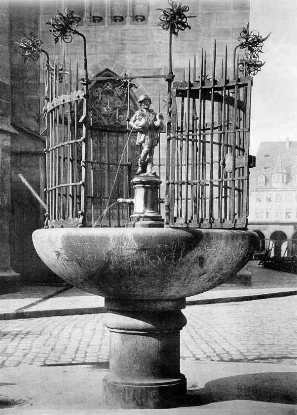
|
| This text, an article from the San Diego local newspaper "Union", depicts the ancient city of Nuremberg prior to the industrial takeoff as seen with the eyes of the German-American Jewish salesman Abraham Rothschild. Despite of some minor inaccuracies concerning historical facts it shows for what Nuremberg was famous before it became infamous in our century: medieval churches and narrow lanes, splendid artifacts and the "Gemuetlickeit" of the city's old inns.
Rothschild was twenty-seven years of age in 1873 when he wrote his letter from Nuremberg, on June 9. It was published on the front page of San Diego's "Union" newspaper on July 9, 1873. Rothschild, born in Bavaria, apparently arrived in the United States in the 1860s and was naturalized on July 23, 1869. His store in San Diego featured "Segars, tobacco, pipes, stationary, cutlery, fancy goods, school books, perfumery, toys, playing cards, Yankee notions, candy, etc." Rothschild went to Germany in 1873 for the double purpose of visiting his family and buying merchandise for his San Diego store. The transcript of his article was taken from The Western States Jewish Historical Quarterly, October 1979, Vol. XII, No. 2, pp. 27-30. I thank Dr. Martha Lev-Zion for making it available to me. |
When I left San Diego, I did not think I should write to The Union from this wonderful old city; but here I am, and I must tell you a little, at least, of this, the most interesting of all the ancient cities of Germany. Nuremberg, as you know, is the third city of Bavaria [second to Munich], and was formerly the greatest and the richest of all the free imperial cities. It has been notable in history from the tenth century, and preserves many churches, several hundred years old. The civilization of the moderns here, as elsewhere (it is true), has made inroads upon historic places; and the venerable walls of the city have given way before the movement of the nineteenth century "enterprise." But there yet remains more of the ancient time in masonry, statuary and art than can be found in any other city of this country.

The view from the Reichsschloss, or Imperial Castle, is majestic. On the one side you see the whole city, and on the other the surrounding villages, from eight to ten miles off. I visited the Rathshouse (City Hall) - a very old building; the walls within and without inlaid with statues of the middle ages. The German Museum here is one of the greatest in Southern Germany; its collections are rare and wonderful ... The Schoene-brunn (fountain) opposite the old Catholic church, is another work of art and is of great antiquity. The water runs day and night and the servant girls come here to fill their "budden" (water-buckets) which they carry on their backs all day long. There are statues of remarkable workmanship all around.

The picture galleries here are simply wonderful. They are crowded with the greatest works of the greatest masters from the middle ages to this modern time, among others especially those of the famous Albert [Albrecht] Durer (whose house is still preserved here). I could not attempt a description. Months of time would not exhaust the treasures of art here. I have also visited the Kunst Schule (school of art). It is impossible for me to explain the great and exquisite work exhibited here, done by the hand of man during ages down to this date. It requires a long time to perceive and comprehend; and after you have an idea, you must commence again. (Just here let me tell you that you will have to take these notes in the loose way in which they are written. As you very well know, I don't pretend to be a writer; but simply give you birds-eye glimpses of Nuremberg as seen by my eyes.) Another of the wonders of the place is the statue where the water runs, called Gansmanchen (gooseman). The Lorenzer Kirche, or Church of St. Lorenzo, and Sewalder Kirche, or Church of St. Sewald [Sebald], are noble edifices of very great age. The spectator wonders how such astonishing works could be completed - years, even a century of time was required to build a colossal structure like one of those buildings.

Of modern work in Nuremberg, the greatest is the new Jewish synagogue, which will be completed this year and will cost over a million florins when finished. It will be perhaps the finest place of worship outside of Berlin, except the Temple [Emanu-El] in New York. It is something like the Temple on Sutter Street in San Francisco, but a more majestic work of art. It has three cupolas, and the architecture is of the great old gothic style. The Jewish burying ground is also one of the great sights of the city; you think indeed you are in a garden of flowers. I liked it very much, but did not care - at least for the present - to take up my residence there.
|
JewishGen, Inc. makes no representations regarding the accuracy of
the translation. The reader may wish to refer to the original material
for verification.
JewishGen is not responsible for inaccuracies or omissions in the original work and cannot rewrite or edit the text to correct inaccuracies and/or omissions.
Our mission is to produce a translation of the original work and we cannot verify the accuracy of statements or alter facts cited.
 Leaving Nuremberg
Leaving Nuremberg
 Yizkor Book Project
Yizkor Book Project
 JewishGen Home Page
JewishGen Home Page
Copyright © 1999-2024 by JewishGen, Inc.
Updated 21 June 2003 by LA